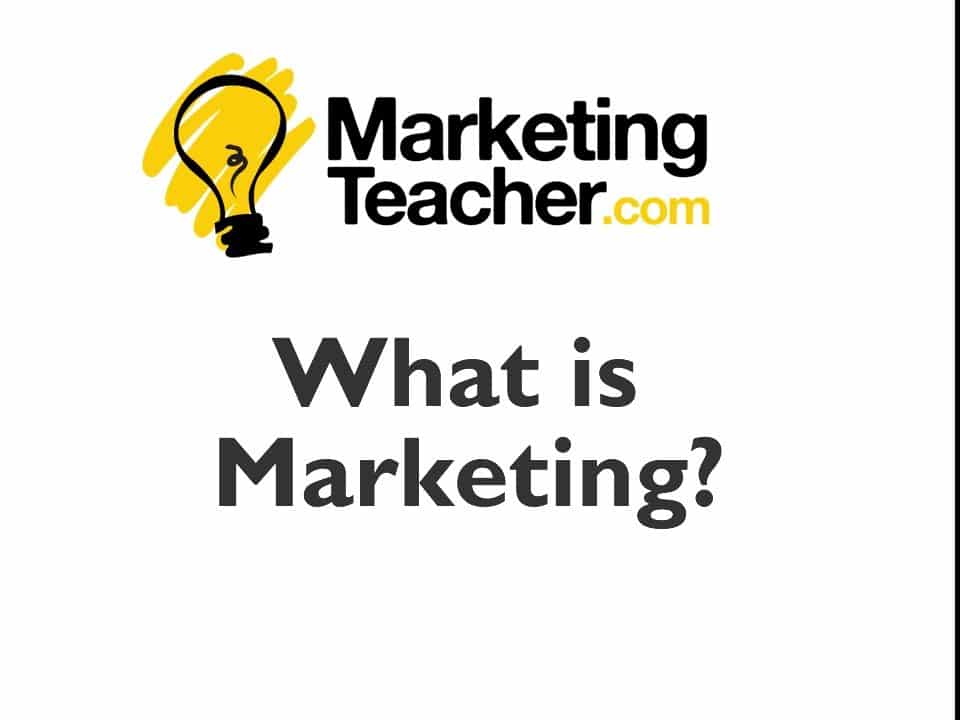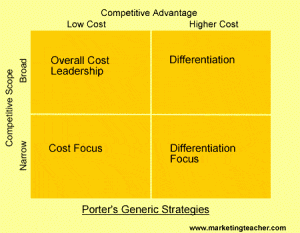

- Directory
- Recent
-
Featured
-
Featured
- Recent
-
- Programs
- Digital Nomad
- Side Gigs
- Resources
Select Page
![]() 10 people find this post amazing!
10 people find this post amazing!

This screen-capture video introduces the topic of marketing. Marketing is defined. NB There is a much newer version of this topic if you visit our youtube page.
There are many marketing definitions. The better definitions are focused upon market orientation and the satisfaction of customer needs.
The definition is based on a basic marketing exchange process and recognizes the importance to the customer.
Kotler and Armstrong develop their original definition to recognize the importance of the longer-term relationship with the customer. This is achieved by relationship marketing and Customer Relationship Management (CRM).
The CIM definition looks at identifying customer needs and satisfying them (short-term), and anticipating them in the future (long-term retention). The definition also states the importance of a process of marketing, with marketing objectives and outcomes. CIM is recognized as being one of the most influential marketing
bodies in the world. It is the professional body for marketing in the United Kingdom.
Again, in common with Kotler and Armstrong above, the AMA focuses its definition on value creation and delivery and the longer-term retained customer.
Baker introduces the elephant in the room. Marketing has always been part of business, and it is a myth that it is purely a contemporary idea.

The concept is simple. Think about another common mix – a cake mix. All cakes contain eggs, milk, flour, and sugar. However, you can alter the final cake by altering the amounts of mixed elements contained in it. So for a sweet cake, add more sugar!
It is the same with the marketing mix. The offer you make to your customer can be altered by varying the mixed elements. So for a high-profile brand, increase the focus on promotion and desensitize the weight given to price.
Another way to think about the marketing mix is to use the image of an artist’s palette. The marketer mixes the prime colors (mix elements) in different quantities to deliver a particular final color. Every hand-painted picture is original in some way, as is every marketing mix. Let’s look at the elements of the marketing mix in more detail. Click on the links to go to the lesson on each element.
The company’s goal in terms of price is really to reduce costs through improving manufacturing and efficiency, and most importantly, the marketer needs to increase the perceived value of the benefits of its products and services to the buyer or consumer.
There are many ways to price a product. Let’s have a look at some of them and try to understand the best policy/strategy in various
situations.
The place is also known as channel, distribution, or intermediary. It is the mechanism through which goods and/or services are moved from the manufacturer/ service provider to the user or consumer.
For many, a product is simply the tangible, physical item that we buy or sell. You can also think of the product as intangible, i.e., a service.
To explore the nature of a product further, let’s consider it as three different products – the CORE product, the ACTUAL product, and finally, the AUGMENTED product.
The Product Life Cycle (PLC) is based upon the biological life cycle. For example, a seed is planted (introduction); it begins to sprout (growth); it shoots out leaves and puts down roots as it becomes an adult (maturity); after a long period as an adult, the plant begins to shrink and die out (decline).
The Customer Life Cycle (CLC) has obvious similarities with the Product Life Cycle (PLC). However, CLC focuses upon creating and delivering lifetime value to the customer, i.e., looks at the products or services that customers NEED throughout their lives.

Physical Evidence is the material part of a service. Strictly speaking, there are no physical attributes to a service, so a consumer tends to rely on material cues. There are many examples of physical evidence, including some of the following buildings, equipment, signs and logos, annual accounts and business reports, brochures, your website, and even your business cards.
People are the most important element of any service or experience. Services tend to be produced and consumed simultaneously, and aspects of the customer experience are altered to meet the individual needs of the person consuming it.
There are several perceptions of the concept of process within the business and marketing literature. Some see processes to achieve an outcome; for example – to achieve a 30% market share, a company implements a marketing planning process. However, it is more about the customer interface between the business and consumer and how they deal with each other in a series of steps in stages, i.e., throughout the process.

Generic strategies were used initially in the early 1980s and seem to be even more popular today. They outline the three main strategic options open to organizations that wish to achieve sustainable competitive advantage. Each of the three options is considered within the context of two aspects of the competitive environment:
The generic strategies are 1. Cost leadership, 2. Differentiation, and 3. Focus.
The low-cost leader in any market gains a competitive advantage from many to produce at the lowest cost. Factories are built and maintained, labor is recruited and trained to deliver the lowest possible costs of production. ‘cost advantage’ is the focus. Costs are shaved off every element of the value chain. Products tend to be ‘no frills.’ However, low cost does not always lead to low prices. Producers could price at competitive parity, exploiting the benefits of a bigger margin than competitors. Some organizations, such as Toyota, are very good not only at producing high-quality autos at a low price but have the brand and marketing skills to use a premium pricing policy.
Differentiated goods and services satisfy the needs of customers through a sustainable competitive advantage. This allows companies to desensitize prices and focus on the value that generates a comparatively higher price and a better margin. The benefits of differentiation require producers to segment markets to target goods and services at specific segments, generating a higher than average price. For example, British Airways differentiates its service.
The differentiating organization will incur additional costs in creating its competitive advantage. These costs must be offset by the increase in revenue generated by sales. Costs must be recovered. There is also the chance that competitors could copy any differentiation. Therefore there is always an incentive to innovated and continuously improve.
The focus strategy is also known as a ‘niche’ strategy. An organization can afford neither a wide scope cost leadership nor a wide scope differentiation strategy, and a niche strategy could be more suitable. Here an organization focuses effort and resources on a narrow, defined segment of a market. Competitive advantage is generated specifically for the niche. Smaller firms often use a niche strategy. A company could use either a cost focus or a differentiation focus.
A firm aims to be the lowest-cost producer in that niche or segment with a cost focus. With a differentiation focus, a firm creates a competitive advantage through differentiation within the niche or segment. There are potential problems with the niche approach. Small, specialist niches could disappear in the long term. Cost focus is unachievable with an industry depending upon economies of scale, e.g., telecommunications.
Make sure that you select one generic strategy. It is argued that if you select one or more approaches and then fail to achieve them, that your organization gets stuck in the middle without a competitive advantage.
Success is not final, failure is not fatal: It is the courage to continue that counts.
–Winston Churchill (1874-1965), former Prime Minister of the United Kingdom
I was taught the way of progress is neither swift nor easy.
–Marie Curie (1867-1934), French physicist and two-time winner of the Nobel Prize
Let me tell you the secret that has led to my goal. My strength lies solely in my tenacity.
–Louis Pasteur (1822-1895), scientist and inventor of the pasteurization process
Learn More about Online Marketing Classroom: Click Here Now!
Learn More about the Academy here: Click Here Now!
The Crucial Constructs Academy is a Free Video Training Course Available only to our Readers and Subscribers. A thorough and detailed training available to you. Find out more about it here. Click and Learn.
There is nothing like having your own online business. You make the decisions, and as one song says, you “win or learn”. However, creating your own company can be tricky. Especially if you are building from the ground up. There will be constant questions that must be answered, such as:
How will we consistently draw in customers? How will we stay up with trends? How will we do all of this and not break the bank? It quickly becomes obvious that one thing is needed above all else-
Without accurate facts and data, wrong decisions get made. When a fork in the road comes up, a turn can become a dead end.
What is the most common way to find information right now? If you said, “Google it!” you are right.
Unfortunately, Google isn’t an encyclopedia. It is a place where people upload information and sometimes that information isn’t as reliable as we would like it to be. In fact, there are some people who put false information online just to see what effect it might have.
But if you, as a new business owner, go to Google and receive false answers to your questions, you could lose your business. At the very least, you might lose money, time, or a good reputation.
One of the most damaging falsehoods—also known as a scam—is the type that asks for people to “invest” in a company. Then, that company will help the person earn unbelievable amounts of money.
It takes work to locate mentors and assistants who will help your business take off, and will do it without taking your shirt.
Our company has people like:
Excellent online marketers who will train and do the legwork. Come to the Largest Online Marketing Event given for new business owners in 2021.
There is no cost! It is FREE! Just click here to join (or copy and paste URL) Biggest Online Marketing Event for Newbies This Year Get Started
These are some of the bonus resources that will be downloadable that you receive after joining. You will be notified how to pick these up from a specific download location after signing up.
These include Special Reports, ebooks, Ultimate Guides, and checklists. They are usually in pdf format so that they can be viewed on any device.
1. Building the Perfect Sales Funnel
3. Creating Your First eCommerce Website
5. Essential Guide to Sales Funnels
6. Newbies Guide to Setting Up a Sales Funnel
7. The Quintessential Guide to Marketing Ads
Our Special Report on Market Timing includes 10 sections about how savvy investors use Trend Investing and Market Timing to vastly improve their returns. This report does not show you the step-by-step system but it explains what Market Timing is, and how when it is combined with Trend Following, Trend Trading, and Trend Timing you can vastly improve your returns.
You will learn
If you would like a copy of this Special Report as well as our Special Report on Trend Following Strategies please fill out the request below and we will send you a pick-up link along with some other strategies to know and understand before you select.
[aweber listid=”5669739″ formid=”817860562″ formtype=”webform”]
Table of Contents

Achieve Your Goals Now!
